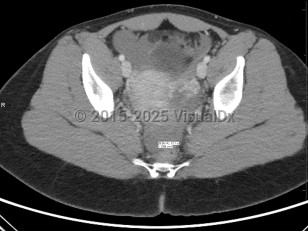In the setting of hemodynamic stability with suspected ectopic pregnancy, provide:
- Emergent gynecologic consultation.
- Vascular access with 2 large bore peripheral intravenous (IV) lines.
- Fluid resuscitation with crystalloid, possible blood products.
The term ectopic pregnancy refers to implantation of a developing blastocyst at any location outside of the endometrial cavity. Ectopic pregnancies can be found in the cervix, cornua, fallopian tubes, ovaries, or a prior cesarean delivery scar, or, more rarely, attached to the abdominal lining, bowel, or other viscera. The most common location is the fallopian tube, specifically the ampulla, which accounts for about 70%-80% of cases, followed by the isthmus and fimbria. Prevalence is estimated at 25 in 1000 pregnancies, with fewer than 200 000 cases in the United States per year. It is a medical emergency.
Ectopic pregnancies are, by definition, nonviable. If left untreated, they may cause their containing structure (eg, fallopian tube, cornua, scar) to rupture, leading to acute blood loss and subsequent morbidity and possibly death. Black women are nearly 7 times as likely as White women to die from the condition due to health disparities and access to care. Improved technology (biochemical markers, ultrasonography, etc) has enabled health care practitioners to identify a majority of ectopic pregnancies before rupture to reduce associated morbidity and mortality.
Ectopic pregnancies are found in reproductive-age patients. Risk factors include prior ectopic pregnancy, history of endometriosis or tubal infection (pelvic inflammatory disease), pregnancy occurring in the setting of current use of a progesterone intrauterine device (IUD), history of tubal surgery, advanced maternal age (aged 35 years or older at time of due date), and tobacco use. It is also important to note that over 50% of all patients diagnosed with an ectopic pregnancy have no known risk factors.
Presentation can vary. Patients may present with a positive home pregnancy test and unilateral lower quadrant pain that is often sharp / stabbing in nature. Some will present after tubal rupture and be hemodynamically unstable. Others may present with only vaginal spotting and be unaware they are even pregnant. Therefore, one must have a high index of suspicion when a patient arrives with a positive pregnancy test and symptomatology. As many as 18% of women presenting to the emergency department with first-trimester bleeding, pain, or both will be found to have an ectopic pregnancy.
Ruptured ectopic pregnancy can result in intraperitoneal bleeding, uterine hemorrhage, and hemodynamic instability. Development of any of these complications should be considered a surgical emergency and warrants emergent evaluation by a gynecologic surgeon; exploratory laparotomy may be required. Even in the absence of concern for rupture, surgery may be considered, particularly in patients failing or with contraindications to methotrexate, in the setting of heterotopic pregnancy (ectopic pregnancy occurring simultaneously with a viable intrauterine pregnancy; see Look For), or in patients seeking sterilization.
A 2011 consensus statement provides definitions that draw attention to the complexity of evaluating for and diagnosing ectopic pregnancy, with 5 categories based on sonographic findings:
- Definitive intrauterine pregnancy
- Probable intrauterine pregnancy
- Pregnancy of unknown location
- Probable ectopic pregnancy
- Definite ectopic pregnancy


